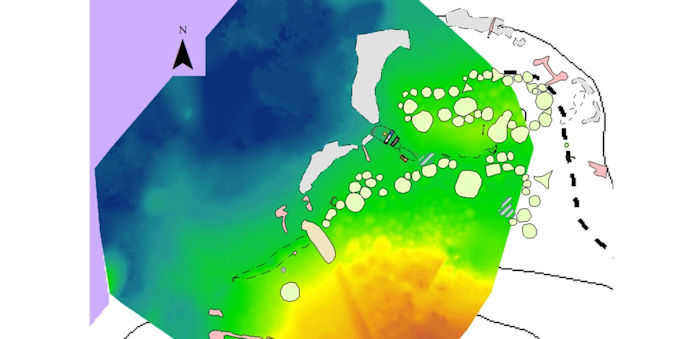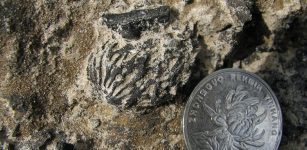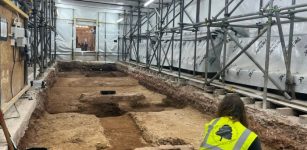Unique Viking Age Shipyard Discovered At Birka Challenges Maritime Activities Of The Viking Age
Conny Waters - AncientPages.com - Scientists have located a unique Viking Age shipyard site at Birka on Björkö in Lake Mälaren.
The discovery challenges previous theories about how the maritime activities of the Viking Age were organized.
A replica of the Viking Age ship at Birka. Credit: Sven Isaksson
“A site like this has never been found before, it is the first of its kind, but the finds convincingly show that it was a shipyard”, says Sven Isaksson, Professor of Archaeological Science at Stockholm University, who led the investigations together with Sven Kalmring, associate professor at Stockholm University and expert on ports and urbanization in the Viking Age at the Zentrum für Baltische und Skandinavische Archäologie in Schleswig.
Large amounts of boat material
The site found consisted of a stone-lined depression in the Viking Age shore zone with a wooden boat slip at the bottom. The finds at the site consist of large quantities of both unused and used boat rivets, whetstones made from slate, and woodworking tools.
The site found consisted of a stone-lined depression in the Viking Age shore zone with a wooden boat slip at the bottom. The finds at the site consist of large quantities of both unused and used boat rivets, whetstones made from slate and woodworking tools. Credit: Paul Parker /Stockholm University
“The finds of artifacts from the area show with great clarity that this is where people have served their ships”, says Sven Isaksson.
Rich maritime cultural landscape
Previous investigations have observed several of the remains before, but it is through the latest finds that it has become possible to take a comprehensive view.
“Through a systematic survey, mapping, and drone investigations, we can now show that Birka, in addition to the urban environment, also has a very rich maritime cultural landscape with remains of everything from jetties to boat launches and shipyards”, says Sven Isaksson.
As explained earlier on AncientPages.com, "established in the middle of the 8th century, Birka was an important trade hub for goods from Scandinavia, Central, and Eastern Europe, and the Orient.
About the 10th century, Birka had approximately 1,000 inhabitants. It had its own Thing, Viking law and order, based on the so-called Thing system. A Thing was the governing assembly made up of the free people of the community. Each community had its own independent Thing where all free Vikings could gather to make law, make decisions and resolve disputes.
The major source of Birka’s prosperity was the fur trade; ships transported fur to many countries in Europe and further to Caliphate in Baghdad. The Vikings traveled east into the Gulf of Finland and continued on the Volga River of Russia, or south to flourishing Gotland and Hedeby. Goods such as iron, horn, and amber were exchanged for silver coins, the coins were usually melted down and turned into jewelry; luxury goods such as silk, glass, and spices were also exchanged.
Exchange of goods and ideas
Ships and shipping are characteristic of the Viking Age in the Nordic countries, both for warfare and trade. One expression of Viking Age long-distance trade is the city-like trading posts that sprang up in the Nordic countries at the time.
Digital 3D model of stone packing on one of the investigated trenches. On top of the stone packing was a layer of sand and originally there was also a wooden boar slip at the bottom. Traces of this can be seen in the form of post-holes and a sandstone frame at the bottom. View to the south. Photogrammetry, modelling and image produced by Fredrik Lundström
In Sweden, the best-preserved example is the UNESCO World Heritage site of Birka on Björkö in Lake Mälaren.
“It's not just about the first urban environments, but shows an intensive exchange of trade goods and ideas between people”, says Sven Kalmring.
Archaeologically unexplored
The town ramparts around Birka functioned not only as a defense, but also as a legal, economic and social boundary. Previous investigations of harbor facilities in Birka have mostly been carried out inside the town rampart, in the area known as the Black Earth harbor area, and below the so-called Garrison. The newly discovered shipyard at *Kugghamn is located, along with a number of other maritime remains, outside Birka's town rampart, along the northern shore of Björkö.
Digital terrain model based on a drone survey and levelled with a GNSS receiver. The color scale blue -turquise-bluegreen marks what has been water and beach zone (ca 5,0-5,75 m öh) during the Viking Age. Credit: Mathias Friberg, map by Sven Isaksson.
“By investigating various maritime elements in connection with a possible house site in Kugghamn, we are now trying to get an overall view of a very exciting and previously archaeologically completely unexplored environment”, says Sven Kalmring.
Findings raise new questions
In order to secure source material that can add nuance to our knowledge of Birka's maritime cultural landscape, archaeological investigations are continuing. Among other things, the remains of a boat landing site located outside the town rampart are being investigated, similar to the shipyard site and unlike the previously investigated harbor remains in the Black Earth. Another question the archaeologists are trying to answer is who was allowed to dock were.
See also: More Archaeology News
“Could anyone land anywhere, or did it matter if it was inside or outside the town rampart? There is much to ponder here. But for us, the investigation doesn't end with the fieldwork, we continue in the lab. By using analytical laboratory techniques, we get more information out of the fragmentary source material than is otherwise possible”, says Sven Isaksson.
Written by Conny Waters - AncientPages.com Staff Writer
























